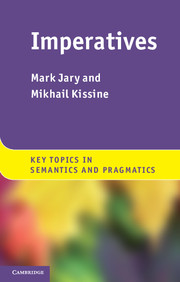Book contents
- Frontmatter
- Contents
- Acknowledgements
- List of abbreviations and notation
- Introduction
- Part I The data
- 1 What is the imperative mood?
- 2 The imperative mood and directive force
- 3 Imperatives with conditional meanings
- Part II The theories
- An opinionated conclusion
- Appendix A Possible worlds and semantics
- Appendix B Modality in possible-word semantics
- Appendix C Stalnaker’s common-ground model of assertion
- Glossary
- References
- Index
3 - Imperatives with conditional meanings
Published online by Cambridge University Press: 05 July 2014
- Frontmatter
- Contents
- Acknowledgements
- List of abbreviations and notation
- Introduction
- Part I The data
- 1 What is the imperative mood?
- 2 The imperative mood and directive force
- 3 Imperatives with conditional meanings
- Part II The theories
- An opinionated conclusion
- Appendix A Possible worlds and semantics
- Appendix B Modality in possible-word semantics
- Appendix C Stalnaker’s common-ground model of assertion
- Glossary
- References
- Index
Summary
In the last chapter, we looked at a range of uses of the imperative and suggested that, given an adequate characterisation of directive force, the imperative mood could safely be seen as having the communicative function of conveying that force. However, we argued that it did not necessarily follow from this that directive force is the encoded meaning of imperative morpho-syntax, but suggested, rather, that a suite-of-features approach was an attractive and viable alternative. In this chapter, we consider further data that might lend support to this view, in that they appear to show that the imperative is sometimes used to convey a conditional meaning, often without an associated directive force.
These data are important because if it can be shown that the imperative can receive a non-directive interpretation, then the case for viewing the imperative as encoding directive force is considerably weakened. Furthermore, these data might provide insights into the encoded meaning of the imperative that are occluded in directive uses. However, a number of authors have argued that, despite appearances to the contrary, some or all cases of what, following Davies (1986), we will call ‘imperative-like conditionals’ or ‘ILCs’ do not, in fact, contain imperatives. Rather, they argue, we are misled into seeing imperatives where there are none by the fact that English uses uninflected root forms for imperatives. Such a claim might be supported by showing that morpho-syntactic behaviour associated with less controversial imperatives is not exhibited by such cases. We therefore need to consider the data carefully before proceeding. At the same time, it will be useful to consider what Davies (1986) refers to as ‘imperative-like ultimatums’ or ‘ILUs’, which are similar, at least superficially, to ILCs in terms of structure and interpretation.
Information
- Type
- Chapter
- Information
- Imperatives , pp. 110 - 162Publisher: Cambridge University PressPrint publication year: 2014
